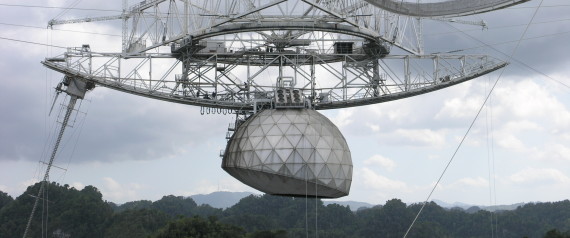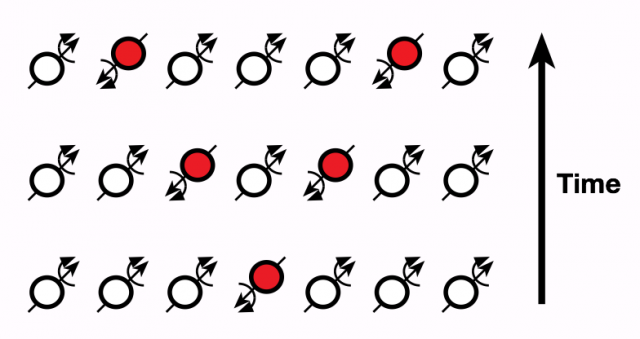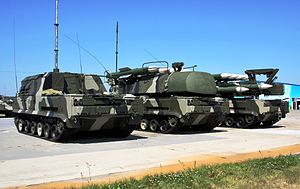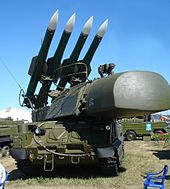From Wikipedia, the free encyclopedia
9K37 Buk
NATO reporting name:
SA-11 Gadfly, SA-17 Grizzly |
|
Buk-M1-2 air defence system in 2010
|
| Type |
Medium range SAM system |
| Place of origin |
Soviet Union |
| Service history |
| In service |
1979–present |
| Used by |
See list of present and former operators |
| Wars |
See combat service |
| Production history |
| Designer |
Almaz-Antey:
- Tikhomirov NIIP (lead designer)
- Lyulev Novator (SA missile designer)
- MNIIRE Altair (naval version designer)
- NIIIP (surveillance radar designer)
- DNPP (missiles)
- UMZ (TELARs)
- MZiK (TELs)[1]
MMZ (GM chassis) |
| Variants |
9K37 "Buk", 9K37M, 9K37M1 "Buk-M1", 9K37M1-2 "Buk-M1-2", 9K37M1-2A, 9K317 "Buk-M2", "Buk-M3"
naval: 3S90 (M-22), 3S90M, 3S90E1, 3S90M1 |
The
Buk missile system (
Russian:
"Бук";
beech,
//) is a family of
self-propelled, medium-range
surface-to-air missile systems developed by the
Soviet Union and its successor state, the
Russian Federation, and designed to fight
cruise missiles,
smart bombs,
fixed- and
rotary-wing aircraft, and
unmanned aerial vehicles.
[2]
The Buk missile system is the successor to the
NIIP/
Vympel 2K12 Kub (
NATO reporting name SA-6 "Gainful").
[3] The first version of
Buk adopted into service carried the
GRAU designation
9K37 and was identified in the west with the NATO reporting name
"Gadfly" as well as the
US Department of Defense designation
SA-11.
Since its initial introduction into service the Buk missile system has
been continually upgraded and refined. With the integration of a new
missile the
Buk-M1-2 and
Buk-M2 systems also received a new NATO reporting name
Grizzly and a new DoD designation
SA-17. The latest incarnation
"Buk-M3" is scheduled for production.
[4]
A naval version of the system, designed by
MNIIRE Altair (currently part of
GSKB Almaz-Antey) for the
Russian Navy, according to
Jane's Missiles & Rockets, received the
GRAU designation
3S90M1 and will be identified with the NATO reporting name
Gollum and a DoD designation
SA-N-7C. The naval system is scheduled for delivery in 2014.
[5]
The apparent shootdown of
Malaysia Airlines Flight 17 on July 17, 2014 is believed to have been caused by the Buk system, giving the weapon international attention.
Development
Development of the 9K37 "Buk" was started on 17 January 1972 at the request of the
Central Committee of the CPSU.
[6]
The development team comprised many of the same institutions that had
been responsible for the development of the previous 2K12 "Kub" (NATO
reporting name "Gainful", SA-6). These included the
Tikhomirov Scientific Research Institute of Instrument Design (NIIP) as the lead designer and the
Novator design bureau who were responsible for the development of the missile armament.
[6]
In addition to the land based missile system a similar system was to be
produced for the naval forces, the result being the 3S90 "Uragan" (
Russian:
"Ураган";
hurricane) which also carries the SA-N-7 and "Gadfly" designations
The Buk missile system was designed to surpass the 2K12 Kub in all parameters and its designers including its chief designer
Ardalion Rastov visited Egypt in 1971 to see Kub in operation.
[8]
Both the Kub and Buk used self-propelled launchers developed by
Ardalion Rastov. As a result of this visit the developers came to the
conclusion that each Buk
transporter erector launcher (TEL) should have its own fire control radar rather than being reliant on one central radar for the whole system as in Kub.
[8] The result of this move from TEL to
transporter erector launcher and radar (TELAR) was a system able to engage multiple targets from multiple directions at the same time.
During development in 1974, it was identified that although the Buk
missile system is the successor to the Kub missile system both systems
could share some interoperability, the result of this decision was the
9K37-1 Buk-1 system.
[6]
The advantage of interoperability between Buk TELAR and Kub TEL was an
increase in the number of fire control channels and available missiles
for each system as well as a faster service entry for Buk system
components. The Buk-1 was adopted into service in 1978 following
completion of state trials while the complete Buk missile system was
accepted into service in 1980
[8] after state trials took place between 1977 and 1979.
[6]
The naval variant of the 9K37 "Buk", the 3S-90 "Uragan" was developed by the
Altair design bureau under the direction of chief designer G.N. Volgin.
[9]
The 3S-90 used the same 9M38 missile as the 9K37 though the launcher
and associated guidance radars were exchanged for naval variants. The
9S-90 system was tested between 1974–1976 on the
Kashin-class destroyer Provorny, and accepted into service in 1983 on the Project 956
Sovremenny-class destroyers.
[9]
No sooner than the 9K37, "Buk" had started to enter service than the
next phase of its development was put into operation, in 1979 the
Central Committee of the CPSU authorised the development of a modernised
9K37 which would become the 9K37M1 Buk-M1, adopted into service in
1983.
[6] The modernisation improved the performance of the systems radars, kill probability and resistance to
electronic countermeasures
(ECM). Additionally a non-cooperative threat classification system was
installed, allowing targets to be classified without IFF via analysis of
return radar signals.
[8] The export version of Buk-M1 missile system is known as "Gang" (
Russian:
"Ганг";
Ganges)
[citation needed].
Another modification to the Buk missile system was started in 1992
with work carried out between 1994 and 1997 to produce the 9K37M1-2
Buk-M1-2,
[6] which was accepted into service in 1998.
[10]
This modification introduced a new missile, the 9M317 which offered
improved kinematic performance over the previous 9M38 which could still
be used by the Buk-M1-2. Such sharing of the missile type caused a
transition to a different
GRAU
designations – 9K317 which has been used independently for all later
systems. The previous 9K37 series name was also preserved for the
complex as was the "Buk" name. The new missile as well as a variety of
other improvements allowed the system to intercept ballistic missiles
and surface targets as well as offering improved performance and
engagement envelope against more traditional targets like aircraft and
helicopters.
[6]
The 9K37M1-2 Buk-M1-2 also received a new NATO reporting name
distinguishing it from previous generations of the Buk system, this new
reporting name was the SA-17 Grizzly. The export version of the 9K37M1-2
system is called "Ural" (
Russian:
"Урал")

Shtil-1 SA missile system (graphic)
The introduction of the 9K37M1-2 system for the land forces also
marked the introduction of a new naval variant, the "Ezh" which carries
the NATO reporting name SA-N-7B 'Grizzly' (9M317 missile) and was
exported under the name "Shtil" and carries a NATO reporting name of
SA-N-7C 'Gollum' (9M317E missile), according to
Jane's catalogue.
[7]
The 9K317 incorporates the 9M317 missile to replace the 9M38 used by
the previous system. A further advancement of the system was unveiled as
a concept at
EURONAVAL
2004, a vertical launch variant of the 9M317, the 9M317ME, which is
expected to be exported under the name 3S90E "Shtil-1". Jane's also
reported that in the Russian forces it would have a name of 3S90M
"Smerch" (
Russian:
"Смерч", English translation: '
tornado').
[9][11][12]
The Buk-M1-2 modernisation was based on a previous more advanced developmental system referred to as the 9K317 "Buk-M2".
[6]
This modernisation featured new missiles and a new third generation
phased array fire control radar allowing engagement of up to four
targets while tracking a further 24. A new radar system was also
developed which carried a fire control radar on a 24 m extending boom,
reputedly improving performance against targets flying at low altitude.
[13]
This new generation of Buk missile systems was stalled due to poor
economic conditions after the fall of the Soviet Union. The system was
presented as a static display at the 2007
MAKS Airshow. The export version of the Buk-M2 missile system Buk-M2E is also known as Ural (
Russian:
Урал; English:
Ural)
[citation needed].
In October 2007, Russian General
Nikolai Frolov, commander of the
Ground Forces'
air defense, declared that the Russian Army would receive the brand-new
Buk-M3 to replace the Buk-M1. He stipulated that the M3 would feature
advanced electronic components and enter into service in 2009.
[14] The upgraded Buk-M3 TELAR will have a seven rollers tracked chassis and 6 missiles in launch tubes.
[15]
Description

Inside the TELAR of a Buk-M1 SAM system
A standard Buk battalion consists of a command vehicle,
target acquisition radar (TAR) vehicle, six
transporter erector launcher and radar
(TELAR) vehicles and three transporter erector launcher (TEL) vehicles.
A Buk missile battery consists of two TELAR and one TEL vehicle. The
battery requires no more than 5 minutes to set up before it is ready for
engagement and can be ready for transit again in 5 minutes. The
reaction time of the battery from target tracking to missile launch is
around 22 seconds.
[citation needed]

Inside the TEL of a Buk-M1-2 SAM system
The Buk-M1-2 TELAR uses the
GM-569 chassis designed and produced by JSC
MMZ (
Mytishchi).
[16] TELAR
superstructure
is a turret containing the fire control radar at the front and a
launcher with four ready-to-fire missiles on top. Each TELAR is operated
by a crew of four and is equipped with
CBRN protection. The radar fitted to each TELAR, referred to as the 'Fire Dome' by NATO, is a
monopulse
type radar and can begin tracking at the missile's maximum range
(32 km/20 mi) and can track aircraft flying at between 15 m and 22 km
(50 to 72,000 ft) altitudes. It can guide up to three missiles against a
single target. The 9K37 system supposedly has much better ECCM
characteristics (i.e., is more resistant to
ECM and
jamming) than the
3M9 Kub system that it replaces. While early Buk had a day radar tracking system 9Sh38 (similar to that used on
Kub,
Tor and
Osa missile system),
its current design can be fitted with a combined optical tracking
system with a thermal camera and a laser range-finder for passive
tracking of the target. The 9K37 system can also utilise the same 1S91
Straight Flush 25 kW
G/
H band continuous wave radar as the 3M9 "Kub" system.
The 9S35 radar of the original Buk TELAR uses mechanical scan of
Cassegrain antenna reflector. Buk-M2 TELAR design used a
PESA for tracking and missile guidance.

A Buk-M1-2 SAM system 9S18M1-1 Tube Arm target acquisition radar (TAR) on 2005
MAKS Airshow
The 9K37 utilises the 9S18 "Tube Arm" or 9S18M1 (which carries the NATO reporting name "Snow Drift") (
Russian:
СОЦ 9C18 "Купол";
dome) target acquisition radar in combination with the 9S35 or 9S35M1 "Fire Dome"
H/
I band
tracking and engagement radar which is mounted on each TELAR. The Snow
Drift target acquisition radar has a maximum detection range of 85 km
(53 mi) and can detect an aircraft flying at 100 m (330 ft) from 35 km
(22 mi) away and even lower flying targets at ranges of around 10–20 km
(6–12 mi). Snow Drift is mounted on a chassis similar to that of the
TELAR, as is the command vehicle. The control post which coordinates
communications between the surveillance radar(s) and the launchers is
able to communicate with up to six TELs at once.

Console of the upgraded TELAR of a Buk-M2E
The TEL reload vehicle for the Buk battery resembles the TELAR but instead of a radar, they have a
crane
for the loading of missiles. They are capable of launching missiles
directly but require the cooperation of a Fire Dome-equipped TELAR for
missile guidance. A reload vehicle can transfer its missiles to a TELAR
in around 13 minutes and can reload itself from stores in around 15
minutes.
Also, Buk-M2 featured a new vehicle like TELAR, but with radar on top of a
telescopic lift,
and without missiles, called a target acquisition radar (TAR) 9S36.
This vehicle could be used together with two TELs 9A316 to engage up to
four targets, missile guidance in forested or hilly regions.
Mobile simulator SAM Buk-M2E was shown at MAKS-2013. Self-propelled
fire simulator installation JMA 9A317ET SAM "Buk-M2E" on the basis of
the mobile is designed for training and evaluating combat crew in the
work environment to detect, capture, maintenance and defeat targets.
Computer Information System fully record all actions of the crew to a
"black box" to allow objectively assess the consistency of the actions
and results.
[17]
All vehicles of Buk-M1 (Buk-M1-2) missile system uses an Argon-15A computer as
Zaslon radar
does (the first airborne digital computer designed in 1972 by the
Soviet Research Institute of Computer Engineering (NICEVT, currently
NII Argon) and produced at "
Kishinev plant of 50 Years of USSR".
[18][19]
The vehicles of Buk-M2 (Buk-M2E) missile system use a slightly upgraded
version of Argon-A15K. This processor is also used in such military
systems as
anti-submarine defense Korshun and
Sova, airborne radars for
MiG-31 and
MiG-33, mobile tactical missile systems
Tochka,
Oka and
Volga. Currently, Argons are upgraded into Baget series of processors by NIIP.
Basic missile system specifications
- Target acquisition range (by TAR 9S18M1, 9S18M1-1)
- Range: 140[clarification needed]
- Altitude: 60 meters – 25 kilometers (197 feet – 15.5 miles)
- Firing groups in one division: up to 6 (with one command post)
- Firing groups operating in a sector
- 90° in azimuth, 0–7° and 7–14° in elevation
- 45° in azimuth, 14–52° in elevation
- Radar mast lifting height (for TAR 9S36): 21 meters
- Reloading of 4 missiles by TEL from itself: around 15 minutes
- Combat readiness time: no more than 5 minutes
- Kill probability (by one missile): 90–95%
- Target engagement zone
- Aircraft
- Altitude: 15 meters – 25 kilometers (50 feet – 15.5 miles)
- Range: 3–42 kilometres (2–26 miles)
- Tactical ballistic missiles
- Altitude: 2.0–16 kilometres (1.2–9.9 miles)
- Range: 3–20 kilometres (1.9–12.4 miles)
- Sea targets: up to 25 kilometres (16 miles)
- Land targets: up to 15 kilometres (9.3 miles)
Integration with higher level command posts
The basic
command post
of the Buk missile system is 9С510 (9K317 Buk-M2), 9S470M1-2 (9K37M1-2
Buk-M1-2) and 9S470 (Buk-M1) vehicles organizing the Buk system into a
battery. It is capable of linking with various higher level command
posts (HLCPs).
As an option it could be combined into the brigade with the use of HLCP, but not mixing into a unified battery.
The Buk missile system may be controlled by an upper level command post system
9S52 Polyana-D4 integrating it with S-300V/
S-300VM into an air defence brigade.
[20][21] Also it may be controlled by an upper level command post system 73N6ME «Baikal-1ME»
[22] together with 1-4 units of
PPRU-M1 (PPRU-M1-2), integrating it with SA-19 "Grison" (
9K22 Tunguska) (6-24 units total) into an air defence brigade.
[23] With the use of the mobile command center
Ranzhir or
Ranzhir-M (
GRAU designations 9S737, 9S737М) the Buk missile system allows to create mixed groups of air defense forces, including
Tor,
Tungushka,
Strela-10, and
Igla.
[24] "Senezh"
[25] is another optional command post for a free mixing of any systems.
3S90 "Uragan"
The 3S90 "Uragan" (
Russian:
Ураган;
hurricane)
is the naval variant of the 9K37 "Buk" and has the NATO reporting name
"Gadfly" and US DoD designation SA-N-7, it also carries the designation
M-22. The export version of this system is known as "Shtil" (
Russian:
Штиль;
still).
The 9М38 missiles from the 9K37 "Buk" are also used on the 3S90
"Uragan". The launch system is different with missiles being loaded
vertically onto a single arm trainable launcher, this launcher is
replenished from an under-deck magazine with a 24 round capacity,
loading takes 12 seconds to accomplish.
[9] The Uragan utilises the MR-750 Top Steer
D/
E band
as a target acquisition radar (naval analogue of the 9S18 or 9S18M1)
which has a maximum detection range of 300 km (190 mi) depending on the
variant. The radar performing the role of the 9S35 the 3R90 Front Dome
H/
I band tracking and engagement radar with a maximum range of 30 km (19 mi).
3S90 "Ezh"
The modernised version of the 3S90 the 9K37M1-2 (or 9K317E) "Ezh"
which carries the NATO reporting name "Grizzly" or SA-N-12 and the
export designation "Shtil" was developed which uses the new 9M317
missile. This variant was supposed to be installed on Soviet
Ulyanovsk-class nuclear aircraft carriers, and has been retrofitted to the
Sovremenny-class destroyers.
[citation needed].
In 1997, India signed a contract for the three Project 1135.6
frigates with "Shtil". Later, when the decision was made to modernize it
with a new package of hardware & missiles, the name changed to
"Shtil-1".
3S90M "Shtil-1"
In 2004, the first demonstration module of the new 9M317ME missile was presented by
Dolgoprudniy Scientific and Production Plant for the upgraded 3S90M "Shtil-1" naval missile system (jointly with
'Altair'). Designed primary for the export purpose, its latest variant used a
vertical launch
missile which is fired from under-deck silos clustered into groups of
twelve, twenty-four or thirty-six. The first Shtil-1 systems were
installed into ships exported to India and China.
[26][27] Old systems Uragan, Ezh and Shtil could be upgraded to Shtil-1 by replacing the launcher module inside the ship.
Missiles
| 9М38 |
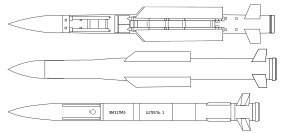
Comparison of 9M38M1, 9M317 and 9M317ME surface-to-air missiles of the Buk missile system
|
| Type |
Surface-to-air missile |
| Place of origin |
Soviet Union |
| Production history |
| Variants |
9М38, 9М38M1, 9M317 |
| Specifications (9М38, 9M317) |
| Weight |
690 kg, (1521 Lbs) 715 kg,(1576 Lbs) |
| Length |
5.55 m (18'-3") |
| Diameter |
0.4 m (15 3/4") (wingspan 0.86 m)(2'-10") |
| Warhead |
Frag-HE |
| Warhead weight |
70 kg,(154.3 Lbs) |
|
Detonation
mechanism
|
Radar proximity fuse |
|
| Propellant |
Solid propellant rocket |
|
Operational
range
|
30 kilometres (19 mi) |
| Flight altitude |
14,000 metres (46,000 ft) |
| Speed |
Mach 3 |
|
Guidance
system
|
Semi-active radar homing |
|
Launch
platform
|
See structure |
9М38 and 9М38M1 missile
The 9M38 uses a single-stage X-winged design without any detachable parts; its exterior design is similar to the American
Tartar and
Standard surface-to-air missile series, which led to the half-serious nickname of
Standardski.
[28]
The design had to conform to strict naval dimension limitations,
allowing the missile to be adapted for the M-22 SAM system in the
Soviet Navy.
Each missile is 5.55 m (18.2 ft) long, weighs 690 kg (1,520 lb) and
carries a relatively large 70 kg (150 lb) warhead which is triggered by a
radar
proximity fuze. In the forward compartment of the missile, a semi-active homing radar head (9E50,
Russian:
9Э50, 9Э50М1), autopilot equipment, power source and warhead are located. The homing method chosen was
proportional navigation.
Some elements of the missile were compatible with the Kub's 3M9; for
example, its forward compartment diameter (33 cm), which was less than
the rear compartment diameter.

9M317 surface-to-air missile on the Buk-M2 quadruple launcher.
The 9M38 surface-to-air missile utilizes a two-mode
solid fuel rocket engine with total burn time of about 15 seconds; the
combustion chamber
is reinforced by metal. For the purpose of reducing the centering
dispersion while in flight, the combustion chamber is located close to
the center of the missile and includes a longer gas pipe. A direct-flow
engine was not used because of its instability at large
angle of attack and by a larger air resistance on a passive trajectory section as well as by some technical difficulties.
[citation needed] Those difficulties had already wrecked plans to create the missile for Kub.
[citation needed]
9M38 is capable of readiness without inspection for at least 10 years
of service. The missile is delivered to the army in the 9Ya266 (9Я266)
transport container.
It has been suggested that the
Novator KS-172 AAM-L, an extremely long range
air-to-air missile and possible
anti-satellite weapon, is a derivative of the 9M38.
[citation needed]
9M317 missile
The 9M317 missile was developed as a common missile for the Russian Ground Force's
Soviet Air Defence Forces (PVO) (using
Buk-M1-2) as well as for ship-based PVO of the
Russian Navy (
Ezh). Its exterior design bears a resemblance to the
Vympel R-37 air-to-air missile.
The unified multi-functional 9M317 (export designation 9M317E) can be used to engage aerodynamic, ballistic, above-water and
radio contrast targets from both land and sea. Examples of targets include tactical
ballistic missiles, strategic
cruise missiles,
anti-ship missiles, tactical, strategic and army aircraft and helicopters. It was designed by OJSC
Dolgoprudny Scientific Production Plant
(DNPP). The maximum engagable target speed was 1200 m/s and it can
tolerate an acceleration overload of 24G. It was first used with
Buk-M1-2 system of the land forces and the Shtil-1 system of the naval
forces.
In comparison with 9M38M1, the 9M317 has a larger defeat area, which
is up to 45 km of range and 25 km of altitude and of lateral parameter,
and a larger target classification. Externally the 9M317 differs from
the 9M38M1 by a smaller wing chord. It uses the inertial correction
control system with semi-active radar homing, utilising the
proportional navigation (PN) targeting method.
The semi-active missile homing radar head (used in 9E420,
Russian:
9Э420) as well as 9E50M1 for the 9M38M1 missile (9E50 for 9M38) and 1SB4 for Kub missile (
Russian:
1СБ4) was designed by
MNII Agate (
Zhukovskiy) and manufactured by
MMZ at
Ioshkar-Ola.
9M317M and 9M317A missile development projects
Currently, several modernized versions are in development, including the 9M317M / 9M317ME, and
active radar homing (ARH) missile 9M317A / 9M317MAE.
The lead developer,
NIIP, reported the testing of the 9M317A missile within Buk-M1-2A
"OKR Vskhod" (
Sprout in English) in 2005.
[29] Range is reported as being up to 50 km (31 mi), maximum altitude around 25 km (82,000 ft) and maximum target speed around
Mach 4. The weight of the missile has increased slightly to 720 kg (1587 lb).
The missile's
Vskhod development program for the Buk-M1-2A was
completed in 2011. This missile could increase the survival capability
and firing performance of the Buk-M1-2A using its ability to hit targets
over the skyline.
[30]
In 2011,
Dolgoprudny NPP completed preliminary trials of the new autonomous target missile system
OKR Pensne (
pince-nez in English) developed from earlier missiles.
[30]
9M317ME missile
The weight of the missile is 581 kg, including the 62 kg
blast fragmentation
warhead initiated by a dual-mode radar proximity fuze. Dimensions of
the hull are 5.18 m length; 0.36 m maximum diameter. Range is 2.5–32 km
in a 3S90M "Shtil-1" naval missile system. Altitude of targets from 15 m
up to 15 km (and from 10 m to 10 km against other missiles). 9M317ME
missiles can be fired at 2-second intervals, while its reaction
(readiness) time is up to 10 s.
The missile was designed to be single-staged, semi-active radio command radar homing with inertial guidance.
[26]
The tail surfaces have a span of 0.82 m when deployed after the
missile leaves the launch container by a spring mechanism. Four
gas-control vanes operating in the motor efflux turn the missile towards
the required direction of flight. After the turnover manoeuvre, they
are no longer used and subsequent flight controlled via moving tail
surfaces. A dual-mode solid-propellant rocket motor provides the missile
with a maximum speed of Mach 4.5.
[31]
Original design tree
- 9K37-1 'Buk-1' – First Buk missile system variant accepted into
service, incorporating a 9A38 TELAR within a 2K12M3 Kub-M3 battery.
- 9K37 'Buk'- The completed Buk missile system with all new system components, back-compatible with 2K12 Kub.
- 9K37M1 'Buk-M1' – An improved variant of the original 9K37 which entered into service with the then Soviet armed forces.
- 9K37M1-2 'Buk-M1-2' ('Gang' for export markets) – An improved
variant of the 9K37M1 'Buk-M1' which entered into service with the
Russian armed forces.
- 9K317 'Ural' (9K37M2) – initial design of Buk-M2 which entered into service with the Russian armed forces
- 9K317E 'Buk-M2E' - revised design for export markets[40]
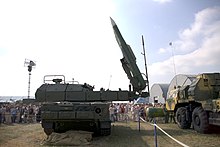
Backside of the 9A317 TELAR of Buk-M2E (export version) at 2007 MAKS Airshow

9A317 TELAR of Buk-M2E (export version) at 2007 MAKS Airshow
- 9K37M1-2A 'Buk-M1-2A' - redesign of Buk-M1-2 for the use of 9M317A missile
- 'Buk-M2EK'[41] – A wheeled variant of Buk-M2 on MZKT-6922 chassis exported to Venezuela and Syria.
- 9K317M 'Buk-M3' (9K37M3) – In Russian some active work is being
conducted, aimed at the new perspective complex of Buk-M3. A
zenith-rocket division of it will have 36 target channels in total. It
will feature advanced electronic components.
Naval version design tree
- 3S90/M-22 'Uragan' (SA-N-7 "Gadfly") – Naval version of the 9K37 Buk missile system with 9M38/9M38M1 missile.
- 3S90 "Ezh" (SA-N-7B/SA-N-12 'Grizzly') – Naval version of the 9K37M1-2 with 9M317 missile.
- 3S90 "Shtil" (SA-N-7C 'Gollum') – Naval export version of the 9K37M1-2 with 9M317E missile.
- 3S90E "Shtil-1" (SA-N-12 'Grizzly') – Naval export version with 9M317ME missile.
- 3S90M "Smerch" (SA-N-12 'Grizzly') – Possible naval version with 9M317M missile.
Copies
 Belarus – In May on the MILEX-2005 exposition in Minsk, Belarus presented their own modification of 9K37 Buk called Buk-MB.[42]
On 26 June 2013 an exported version of Buk-MB was displayed on a
military parade in Baku. It included the new 80K6M Ukrainian-build radar
on an MZKT chassis (instead the old 9S18M1) and the new Russian-build
missile 9M317 (as in Buk-M2).[43]
Belarus – In May on the MILEX-2005 exposition in Minsk, Belarus presented their own modification of 9K37 Buk called Buk-MB.[42]
On 26 June 2013 an exported version of Buk-MB was displayed on a
military parade in Baku. It included the new 80K6M Ukrainian-build radar
on an MZKT chassis (instead the old 9S18M1) and the new Russian-build
missile 9M317 (as in Buk-M2).[43] People's
Republic of China – HQ-16 (Hongqi-16) - People's Republic of China
project based on the naval 9K37M1-2 system 'Shtil' (SA-N-12).[44]
Other sources also rumored the project involved some Buk technology. It
is able to engage high altitude and very low flying targets.[45]
The most visual distinction between SA-17 and HQ-16 is that the latter
is truck-based and vertically launched instead of track based SA-17, its
total number of missiles increased to six from the original four in
SA-17 system.
People's
Republic of China – HQ-16 (Hongqi-16) - People's Republic of China
project based on the naval 9K37M1-2 system 'Shtil' (SA-N-12).[44]
Other sources also rumored the project involved some Buk technology. It
is able to engage high altitude and very low flying targets.[45]
The most visual distinction between SA-17 and HQ-16 is that the latter
is truck-based and vertically launched instead of track based SA-17, its
total number of missiles increased to six from the original four in
SA-17 system.
 People's Republic of China – HQ-16A – Improvement of the HQ-16, with redesigned control surfaces incorporating leading edge, thus has better performance at higher angle of attack than HQ-16.
People's Republic of China – HQ-16A – Improvement of the HQ-16, with redesigned control surfaces incorporating leading edge, thus has better performance at higher angle of attack than HQ-16. People's Republic of China – HQ-16B – Further improvement of HQ-16A[46][47]
People's Republic of China – HQ-16B – Further improvement of HQ-16A[46][47] People's Republic of China – LY80 – Export version of HQ-16A,[48][49] incorporating cold vertical launch method
People's Republic of China – LY80 – Export version of HQ-16A,[48][49] incorporating cold vertical launch method
 Iran – Raad
Medium Ranged Surface-to-Air Missile System using Ta'er 2 missiles. It
has very similar layout to wheeled Buk-M2EK 9M317. It was shown during
2012 military parade.[50]
Iran – Raad
Medium Ranged Surface-to-Air Missile System using Ta'er 2 missiles. It
has very similar layout to wheeled Buk-M2EK 9M317. It was shown during
2012 military parade.[50]
Operational service

TELAR of
Finnish 9K37M1 Buk-M1 (SA-11 Gadfly) from the left side (missiles locked in a transport position)
In 1996 Finland started operating the eighteen missile systems that they received from Russia as debt payment.
[76] According to
Suomen Kuvalehti,
Finland is planning to accelerate the replacement of the missile system
due to concerns about its susceptibility to electronic warfare.
[77][78]
Combat service
Abkhaz authorities claimed that Buk air defense system was used to shoot down four Georgian drones at the beginning of May 2008.
[79]
Analysts concluded that Georgian Buk missile systems were responsible for downing four Russian aircraft—three
Sukhoi Su-25 close air support aircraft and a
Tupolev Tu-22M strategic bomber—in the
2008 South Ossetia war.
[80]
U.S. officials have said Georgia's SA-11 Buk-1M was certainly the cause
of the Tu-22M's loss and contributed to the losses of the three Su-25s.
[81]
According to some analysts, the loss of four aircraft is surprising and
a heavy toll for Russia given the small size of Georgia's military.
[82][83] Some have also pointed out, that Russian
electronic counter-measures systems were apparently unable to jam and suppress enemy SAMs in the conflict
[84] and that Russia was, surprisingly, unable to come up with effective countermeasures against missile systems it had designed.
[80]
Georgia bought these missile systems from Ukraine which had an inquiry to identify if the purchase was illegal.
[85]
On 29 January 2013, the
Israeli Air Force launched an airstrike on a convoy in Syria believed to have SA-17 BUK-M2E missiles bound for
Hezbollah in Lebanon. The Syrian government denied that the shipment of weapons was taking place.
[86]
The system is suspected of having been involved in the downing of
Malaysia Airlines Flight 17 (a
Boeing 777-200ER) on 17 July 2014 with 298 fatalities in eastern Ukraine's Donetsk Oblast.
[87]
Videos posted by Russian-backed separatist forces after the crash
claimed to have used the system to bring down what they claimed was an
An-26 in the area of the crash, and allegedly showed images of the burning wreckage of MH17 in the distance as evidence.
[
